The Visual Guide to
Bovine Reproduction
- Uterine Torsion
- Strangulated Umbilical Cord
- Pelvic Subluxation
- Prolapsed Vagina
- Prolapse of the Bladder
- Ruptured Prepubic Tendon
- Prolonged Gestation
- Hydrops Allantois
- Hydrops Amnii
- Mummification
- Maceration
Accidents of Gestation: Prolonged Gestation
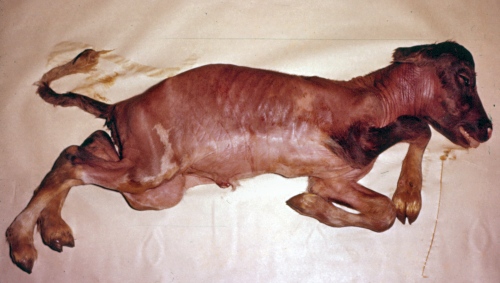
Guernsey Fetus - 6.5 Months.
This 6-month old fetus was 210 days overdue. It ceased growing at about 6 months of gestation due to a nonfunctional pituitary gland. It remained alive in a vegetative state for nearly 10 months. Due to a nonfunctional fetal hypothalamo-pituitary-adrenal action it was also unable to initiate parturition.
Drost M (1968)

Overdue Cow.
While 3 weeks past term (overdue) this cow showed no signs of preparation for delivery. The udder remained flaccid and dry.
Drost M (1967)

No Udder Development.
The udder show no signs of filling in preparation for delivery, even though she was three weeks past term, due to fetal adrenal insufficiency.
Drost M (1967)

Pelvic Ligaments Not Relaxed.
The caudal borders of the sacrosciatic ligaments are not relaxed despite the fact that this cow carries a large live calf and is three weeks past term. [nonfunctional fetal adrenal glands].
Drost M (1967)
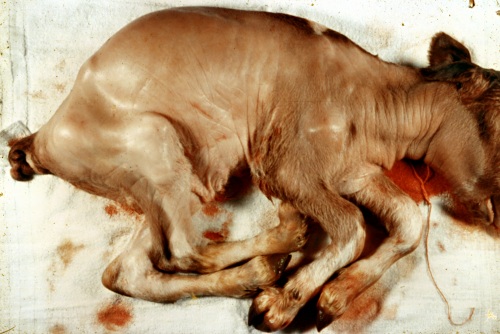
Guernsey Fetus - 7.0 Months.
This fetus failed to initiate parturition due to a defective pituitary gland. It was delivered alive by cesarean section after vegetating in utero for approximately 10 months.
Drost M (1967)
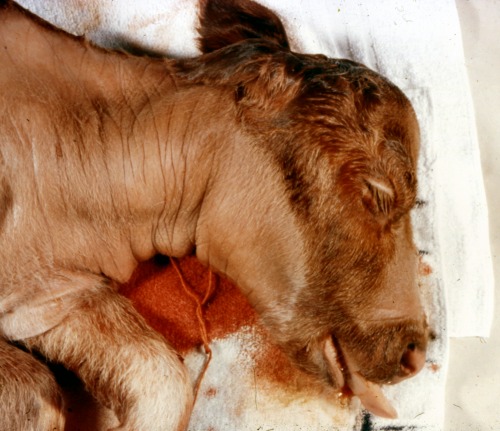
Close-up of Guernsey Fetus.
This fetus failed to initiate parturition due to a defective pituitary gland. It was delivered alive by cesarean section after vegetating in utero for approximately 10 months. Gross appearance of the fetus was that of a 7-month old fetus.
Drost M (1967)
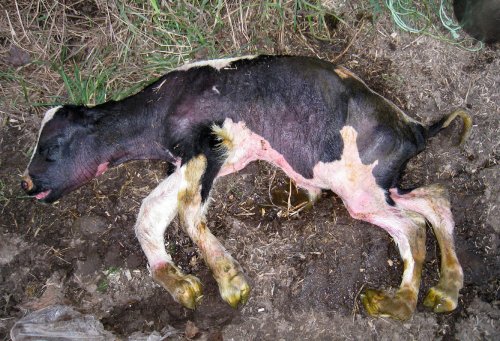
Overdue Holstein Fetus - 7.5 Months.
This 7.5 month old fetus failed to initiate parturition presumably due to a defective pituitary gland. It was delivered alive after induction with 30 mg dexamethasone 91 days after the projected due date. The cervix was fully dilated 3 days later and delivery was by manual extraction. The calf died after several spontaneous breaths. There was a lack of mammary development at the time of delivery. Normal lactation developed later in the 6 year old dam.
Roberts JN (2009)
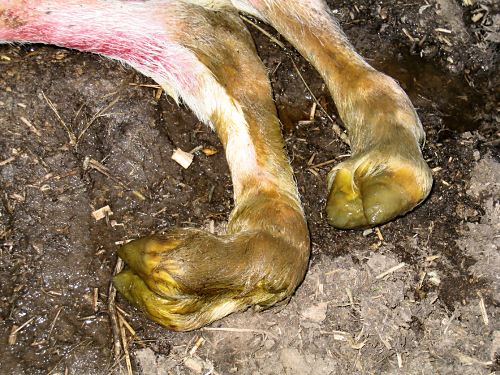
Retroflexed Pasterns of an Overdue Fetus.
This Holstein fetus was retained alive in uterus for 3 months past term. The rear pastern were retroflexed possibly due to uterine crowding as a result of a reduced amount of allantois fluid. Meconium staining indicates hypoxia.
Roberts JN (2009)
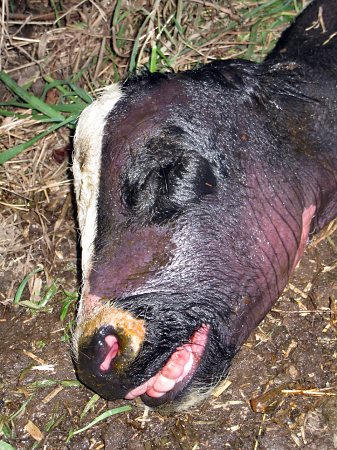
Head of an Overdue Fetus.
This Holstein fetus was retained alive in uterus for 3 months past term. Limited hair development around the muzzle, the eyes, and the ears is characteristic of that of a 7.5 month old fetus.
Roberts JN (2009)
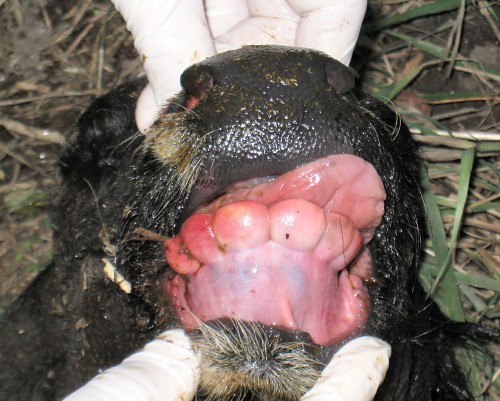
Teeth of an Overdue Fetus.
This Holstein fetus was retained alive in uterus for 3 months past term. The incisors show developmental arrest. The calf was delivered with assistance after induction with 30 mg of dexamethasone three days earlier.
Roberts JN (2009)
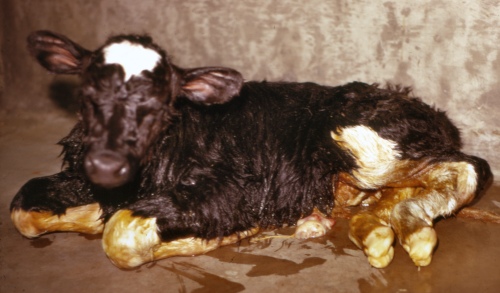
Overdue Holstein Calf.
This overdue Holstein heifer calf was homozygous recessive for the Prolonged Gestation gene, which manifests itself by failure of the initiation of parturition as a result of nonfunctioning adrenal glands. Its postmaturity is evident by the long hair, excessive birthweight, large umbilical stump, and meconium staining. The calf was delivered by cesarean section 38 days past term.
Drost M (1967)
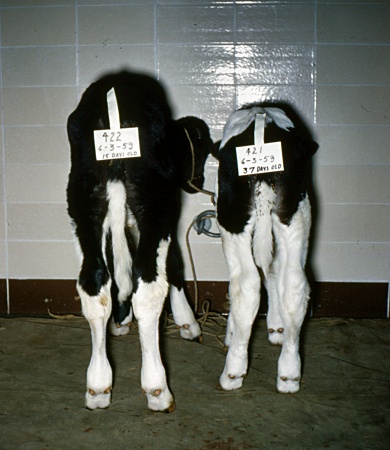
Comparison with Normal Calf.
Congenitally nonfunctional adrenals glands in the calf on the left led to failure to initiate parturition. It was delivered by cesarean section 29 day past term. It is shown here at 15 days after delivery next to a normal spontaneously delivered 37-day old calf.
Drost M (1967)
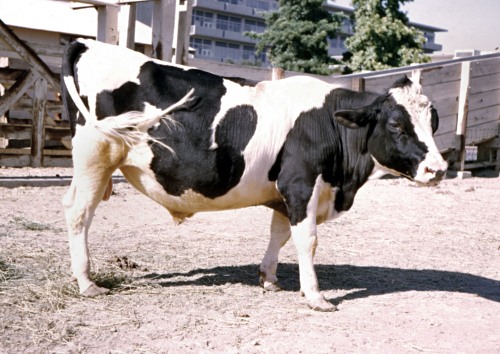
Prolonged Gestation Bull.
This homozygous recessive for prolonged gestation bull was delivered by cesarean section at 35 days past term. The bull calf weighed 72 kg. He was kept alive by daily injections of corticosteroids. The bull was small in stature at 20 months. He produced viable semen.
Drost M (1967)
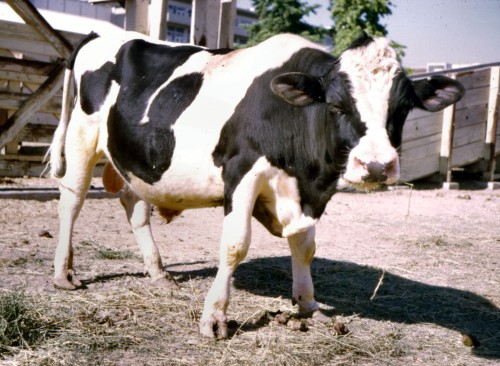
Prolonged Gestation Bull.
Born by cesarean section after failing to initiate parturition, because of nonfunctioning adrenal glands, this bull was kept alive by daily corticosteroid injections. Shown here at 20 months. He produced viable semen.
Drost M (1967)
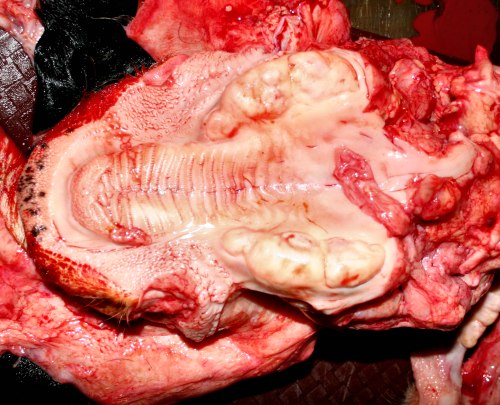
Postmature Tooth Development.
This specimen was from an 80-day post-term, 50 kg, Holstein calf, delivered by cesarean section. It died shortly after delivery. The upper molars show advanced development in this calf that was born by cesarean section one month past term. The gums remained intact. The calf likely suffered from adrenal insufficiency and was unable to initiate parturition.
Breed M (2006)
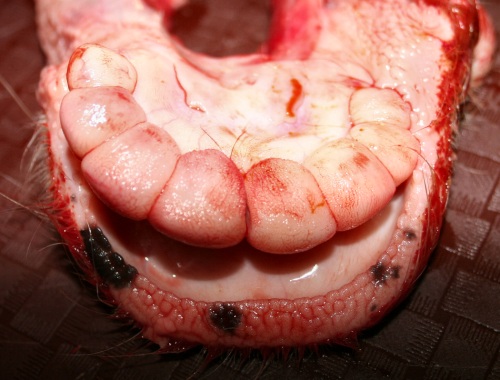
Postmature Tooth Development.
The upper molars show advanced development. The gums remained intact. This specimen was from an 80-day overdue, 50 kg, Holstein calf, delivered by cesarean section. It died shortly after delivery. The calf likely suffered from adrenal insufficiency and was unable to initiate parturition.
Breed M (2006)

Postmature Tooth Development.
The lower incisors and molars show advanced development. The well developed teeth did not erupt through the gums. This specimen was from an 80-day overdue, 50 kg, Holstein calf, delivered by cesarean section. It died shortly after delivery. The calf likely suffered from adrenal insufficiency and was unable to initiate parturition.
Breed M (2006)
